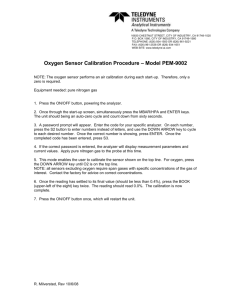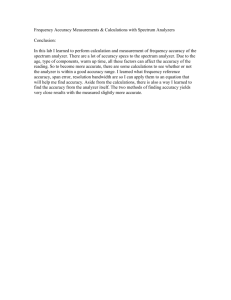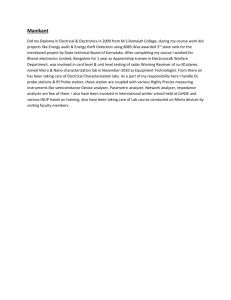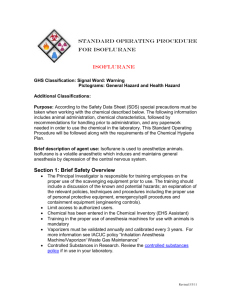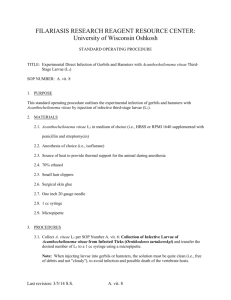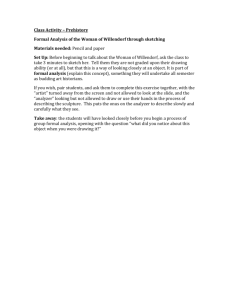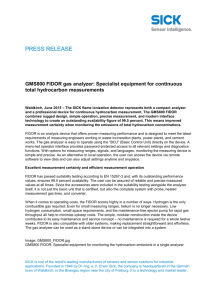Dear Sirs, We believe we have addressed all concerns raised by the
advertisement
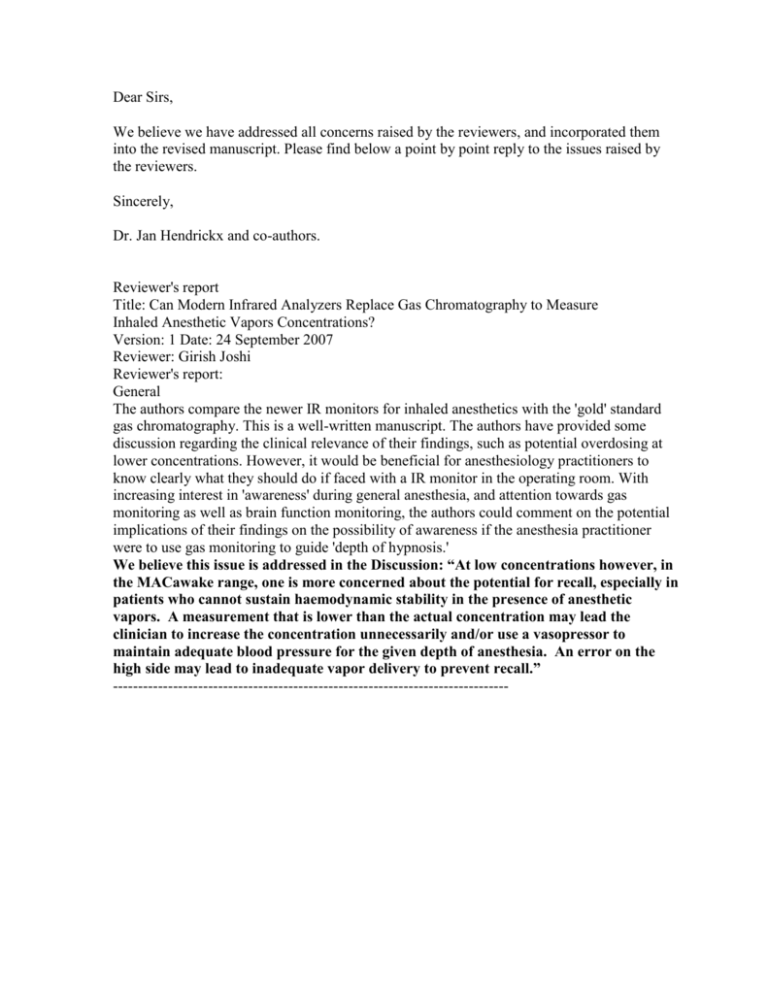
Dear Sirs, We believe we have addressed all concerns raised by the reviewers, and incorporated them into the revised manuscript. Please find below a point by point reply to the issues raised by the reviewers. Sincerely, Dr. Jan Hendrickx and co-authors. Reviewer's report Title: Can Modern Infrared Analyzers Replace Gas Chromatography to Measure Inhaled Anesthetic Vapors Concentrations? Version: 1 Date: 24 September 2007 Reviewer: Girish Joshi Reviewer's report: General The authors compare the newer IR monitors for inhaled anesthetics with the 'gold' standard gas chromatography. This is a well-written manuscript. The authors have provided some discussion regarding the clinical relevance of their findings, such as potential overdosing at lower concentrations. However, it would be beneficial for anesthesiology practitioners to know clearly what they should do if faced with a IR monitor in the operating room. With increasing interest in 'awareness' during general anesthesia, and attention towards gas monitoring as well as brain function monitoring, the authors could comment on the potential implications of their findings on the possibility of awareness if the anesthesia practitioner were to use gas monitoring to guide 'depth of hypnosis.' We believe this issue is addressed in the Discussion: “At low concentrations however, in the MACawake range, one is more concerned about the potential for recall, especially in patients who cannot sustain haemodynamic stability in the presence of anesthetic vapors. A measurement that is lower than the actual concentration may lead the clinician to increase the concentration unnecessarily and/or use a vasopressor to maintain adequate blood pressure for the given depth of anesthesia. An error on the high side may lead to inadequate vapor delivery to prevent recall.” ------------------------------------------------------------------------------- Reviewer's report Title: Can Modern Infrared Analyzers Replace Gas Chromatography to Measure Inhaled Anesthetic Vapors Concentrations? Version: 1 Date: 7 October 2007 Reviewer: Philip Peyton Reviewer's report: General ------------------------------------------------------------------------------Major Compulsory Revisions (that the author must respond to before a decision on publication can be reached) 1. Documentation of reliability and precision of GC (and IR): The paper seems to report the scatter in agreement of individual measurements by GC and IR across a range of gas concentrations and species. My major concern with this study is the authors' assumptions regarding the use of GC as a standard for the assessing the accuracy of IR. The paper seems to largely ignore the issue of reproducibility (precision) of either GC or IR, which makes interpretation of the results difficult. For example, the authors state that the standard deviation (SD) of repeat GC measurements is said to be 2-3% by Dr. Eger. However, they don't document the precision of their own GC measurements, which would be a simple thing to do, taking multiple samples from a given preparation at each concentration. We used the actual equipment (including calibration gas and gas chromatograph) and technique of Dr. Eger. For each agent, a different cylinder with calibration gas is prepared (secondary standard). The exact concentration of this secondary standard is determined by comparing it with a primary volumetric standard using gas chromatography. The primary standard is prepared by injecting a known exact amount of liquid agent (measured by weight or glass micropipette) in a glass Erlenmeyer of known volume, taking the effect of temperature into account. Using this primary standard, it was determined that the concentrations of isoflurane, sevoflurane, and desflurane in the cylinders were 0.744, 1.49, and 4.20%, respectively. Before an after testing each agent with each analyzer, gas from the cylinder with the appropriate calibration gas was injected 3 times to ensure consistency/precision. Based on 6 calibrations per agent per analyzer (3 before and 3 after measuring each agent) a total of 18 GC calibrations were done per agent with the same calibration gas. Over the entire course of the study, the peak height with the same calibration gas for isoflurane (0.744%), sevoflurane (1.49%), and desflurane (4.20%) was 54.0 mm (standard deviation 1.1 mm) for isoflurane, 52.2 mm (standard deviation 2.0 mm) for sevoflurane, and 54.1 mm (standard deviation 1.4mm) for desflurane. The coefficient of variation for isoflurane, sevoflurane, and desflurane therefore was 2.0, 3.8, and 2.6 % respectively. This information has been added to the Methods section. There appears to be considerable scatter in GC measurements along the x-axis in Figure 1. The variation the reviewer refers to is due to the fact that the exact concentration of the vapor at the common gas outlet slightly differed for each analyzer. For each analyzer, test gases were sampled from the common gas outlet at different times; because vaporizer output (and thus the concentration of vapor at the common gas outlet) may differ slightly from moment to moment, some scatter along the X-axis from figure 1 will be due to the manner in which the test gas was prepared. This information has been added to the Methods section. If the SD of GC = 3%, so 2XSD = 6% either side of the true value. Therefore up to 6% of the scatter in agreement with IR may arise from the GC standard itself. For GC, the coefficient of variation for isoflurane, sevoflurane, and desflurane was 2.0, 3.8, and 2.6 % respectively – see above. Where differences between IR and GC of around 10-20% are being found, should not multiple measurements from each sample be made at each concentration to narrow these GC confidence limits? Of each mixture, we had two samples analyzed by IR and two by GC. At each concentration, how many repeat measures were made (if any)? Over the entire course of the study, repeat measures were made on three occasions because operator error had caused gross errors. This information has been added to the manuscript. On 8 occasions, repeat testing was done because the sampling rate of the IR (200 mL.min-1) was so fast relative to the volume of the syringe that the syringe had run empty and no sample was left for the second GC determination. What are the confidence limits for a given measurement by either GC or IR? They, quite rightly, used the first and last 10 mL of each gas sample for GC analysis and rejected the measurement if these differed by more than 1mm. Perhaps they can tell us how much proportional scatter in GC measurements 1mm represents. Over the entire course of the study, the peak height with the same calibration gas for isoflurane (0.744%), sevoflurane (1.49%), and desflurane (4.2%) was - isoflurane 54.0 mm (standard deviation 1.1) - sevoflurane 52.2 mm (standard deviation 2.0) - desflurane 54.1 mm (standard deviation 1.4%) One mm therefore presents 1.9, 1.9 and 1.8% proportional scatter in GC for isoflurane, sevoflurane, and desflurane measurements. These calculations are based on 6 calibrations, 3 before and 3 after measuring each agent for each analyzer (total of at 18 per analyzer). 2. Details of IR sampling: How was data obtained from the IR device? Was it simply read from the screen of the analyzer? How many digits of precision (at the low concentrations particularly) does this provide? It was downloaded in a spreadsheet every 10 seconds, so 2 or 3 values are obtained per tested sample. The number of digits of precision is 3. How stable was the measured concentration of gas sampled from the glass syringe during this process? To ensure homogeneous mixing, the content of a 50 mL glass syringe was mixed by repeatedly ejecting and aspirating its content into another 50 mL glass syringe using a three-way stopcock. This is mentioned in the Methods: “To ensure adequate mixing of the gases, the mixtures were injected via a three-way stopcock at least 4 times into a second 100 mL glass syringe.” The Methods section also mentions that the difference between the GC before and after the IR had to be less than 1 mm. This gave us additional certainty that the sample was adequately mixed. How did they deal with the problem of the negative pressure generated within the syringe during sampling (this would occur rapidly, since the sampling rate of the IR device is about 200 mL/min). This would potentially cause significant artefact. Inevitable sticking of the plunger of the syringe during sampling would lead to considerable variation in measured partial pressure, and would not be fair test of the device. Both during storage and sampling, the 50 ml glass syringe was placed with the plunger upwards. The weight of the plunger, combined with the very low resistance of the plunger/syringe interface as well as the application of a rotating motion (by hand) on the plunger while sampling ensured that the plunger never got stuck. The syringes did not stick, and negative pressure did never develop. Did they consider using analog download of their IR concentration data to computer memory for inspection and analysis of their concentration waveforms? No. Dr. Peyton himself only recently described this approach (Peyton PJ, Chong M, Stuart-Andrews C, Robinson GJ, Pierce R, Thompson BR. Measurement of anesthetics in blood using a conventional infrared clinical gas analyzer. Anesth Analg 2007;105:680-7). Our paper is in that regard complementary to his findings – IR can be used for research purposes if the individual IR analyzer is calibrated against a volumetric standard. The Discussion does mention that “An alternative interpretation of Peyton’s findings might be that IR analysis could be used if the performance characteristics of the individual IR analyzer are well documented”. ------------------------------------------------------------------------------Minor Essential Revisions (such as missing labels on figures, or the wrong use of a term, which the author can be trusted to correct) Methods: The authors say that they calibrated the GC against secondary (cylinder) standards which had been themselves been calibrated against a primary volumetric standard. I accept this although the details of the preparation of the primary standard are not given. Grammatical corrections: Title: Change to “… Anesthetic Vapor Concentrations?” or “concentration of anesthetic vapors?”. The title has been changed accordingly. P10. Last paragraph. “clinically” not “clinical”. The text has been changed accordingly. Figures: Fig 1 “Company limits”? Explain this term in the Figure legends as well as the text, please. We believe that this was already mentioned in the Discussion: “The performance of the four modules conformed to that specified by the company, +/- (0.15% + 5% of IR reading). We also added it to the legend of figure 1.” Reviewer's report Title: Can Modern Infrared Analyzers Replace Gas Chromatography to Measure Inhaled Anesthetic Vapors Concentrations? Version: 1 Date: 20 September 2007 Reviewer: Joseph F Antognini Reviewer's report: General ------------------------------------------------------------------------------Major Compulsory Revisions (that the author must respond to before a decision on publication can be reached) Page 6, near bottom: Provide more details about how the samples were prepared. Where were the samples drawn from the machine? The gas samples were drawn from the common gas outlet – this information has been added to the manuscript. Did you flush the syringe several times before obtaining the sample? Yes. What was the make and model of the anesthesia machine? The vaporizers? The ADU Anesthesia Delivery Unit by GE, Helsinki, Finland; the vaporizer is an integral part of the ADU. This information has been added to the Methods section. Page 7, near top: You state that > 1 mm variation in peak height resulted in repeating testing, but how much is 1 mm compared to the overall peak? Is 1 mm a little or a lot? How much “1mm” means, does indeed depend on the peak height. The concentration of isoflurane, sevoflurane, and desflurane in the tank containing our secondary standard was 0.744, 1.49, and 4.20%, respectively. Over the entire course of the study, the peak height with the same calibration gas for isoflurane (0.744%), sevoflurane (1.49%), and desflurane (4.20%) was 54.0 mm (standard deviation 1.1) for isoflurane, 52.2 mm (standard deviation 2.0) for sevoflurane, and 54.1 mm (standard deviation 1.4%) for desflurane. One mm therefore presents 1.9, 1.9 and 1.8% proportional scatter in GC for isoflurane, sevoflurane, and desflurane measurements. These calculations are based on 6 calibrations, 3 before and 3 after measuring each agent for each analyzer (total of at 18 per analyzer). This information has been added to the manuscript. How often did you need to repeat testing? Over the entire course of the study, repeat measures were done on three occasions because operator error had caused gross errors. This information has been added to the manuscript. On 8 occasions, repeat testing was done because the sampling rate of the IR (200 mL.min-1) was so fast relative to the volume of the syringe that the syringe had run empty and no sample was left for the second GC determination. Provide more details about the calibration of the GC. What was the range of concentrations of the calibration gases? How exactly were these prepared? The same calibration gas (one for each agent) was used throughout the study. The calibration gas comes out of a stainless steel cylinder which contains a known concentration of vapor; for each agent, a different cylinder was prepared. The mixture is prepared by creating a subatmospheric pressure in the cylinder. Next, an amount of liquid agent is aspirated into the cylinder. This amount is calculated such that after vaporization the calculated pressure in the cylinder will remain below the vapor pressure of the agent. The cylinder is then filled/pressurized with air. To mix its contents, the cylinder is rolled several times, and subsequently heated overnight by applying an external heat pad. The exact concentration of this secondary standard is determined by comparing it with a primary volumetric standard using gas chromatography. The primary standard is prepared by injecting a known exact amount of liquid agent (measured by weight or glass micropipette) in a glass Erlenmeyer of known volume, taking the effect of temperature into account. Using this primary standard, it was determined that the concentrations of isoflurane, sevoflurane, and desflurane in the tank were 0.744, 1.49, and 4.20%, respectively. This information has been added to the manuscript. When were the modules last serviced relative to when you tested them? Is the variation due to some modules being recently serviced, while others were not? Drift over time was not examined, and therefore cannot be addressed. I am not sure what statistical analysis you did to make the claim in table 1 that individual modules differed. Yes they differed, but what test did you use to come up with p=0.004? We believe this was addressed in the Methods section: “To examine the effect of carrier gas and whether analyzers differed in their performance, we used two way ANOVA (factors = carrier gas and analyzer) with the Holm-Sidak method”. When looking at the GC analysis, there is the same amount of variation. So, isn’t it possible there is a problem with there being variation in the way the samples were injected? Please clarify. We don’t think so - the variation the reviewer refers to is due to the fact that the exact concentration of the vapor at the common gas outlet slightly differed for each analyzer. For each analyzer, test gases were sampled from the common gas outlet at different times; because vaporizer output (and thus the concentration of vapor at the common gas outlet) may differ slightly from moment to moment, some scatter along the X-axis from figure 1 will be due to the manner in which the test gas was prepared. This information has been added to the Methods section. -------------------------------------------------------------------------------
